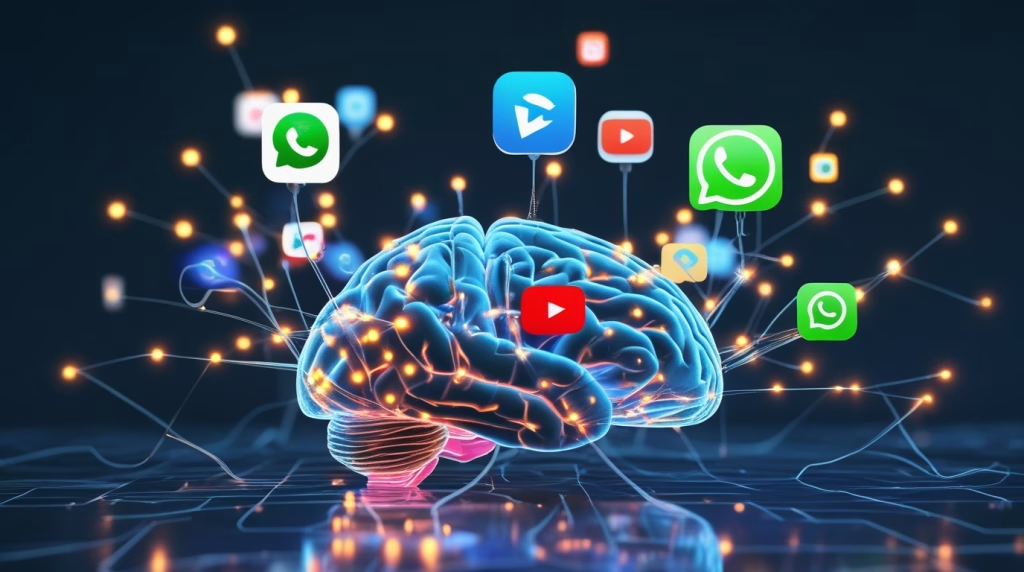Imagine waking up one morning, and instead of reaching for your smartphone to check messages, you simply think about the message — and the reply is sent directly from your brain. No screens. No touch. Just thought.
Welcome to the future, where brain-computer interfaces (BCIs) like Neuralink might make smartphones unnecessary.
Table of Contents
The Journey from Telephones to Thought Communication

Let’s rewind.
Just two decades ago,, the phone was actually huge, though it was only able to make calls and send text messages. The smartphone revolution then came our way – taking the world at our finger tips. We began using the phone to take pictures, to order taxis, to attend a conference, and even to and run entire companies out of their palms.
However, each revolution leaves space to another one.
The next jump is no longer about computing at an even faster pace or taking high-resolution photos but about not having devices at all. This is the point where Neuralink comes in.
check out our latest roundup of the Best Budget Smartphones Under ₹20,000 in India (2025).
Neuralink: What Is It and How Does It Work?

Neuralink is a neurotechnology company co-founded by Elon Musk in 2016. Its aim is to develop brain-computer interfaces (BCIs) that enable humans to connect their brains directly to computers. The concept is both straightforward and significant: since the brain is the most powerful computer we know of, why not link it directly to machines and eliminate the physical devices that facilitate our interactions?
Neuralink is focused on developing a device designed to read and interpret neural activity from within the brain. This innovative implant has potential applications across a range of fields, particularly in medicine, where it could help treat neurological conditions. Additionally, it may facilitate new forms of communication for individuals with impairments.
Neuralink’s technology works by placing very thin electrodes in the brain. These electrodes can pick up the electrical signals that neurons use to communicate. The information they gather is sent to a computer or digital device, allowing the brain to connect with it directly.
Replacing Smartphones with Thought

Neuralink could change how we use smartphones. Instead of needing a phone, you could use your thoughts to send messages, make calls, and share videos. With a Neuralink device in your brain, you would communicate directly with the digital world. Here’s how it might work:
1. Making Calls
Imagine you need to make a call. Instead of dialing a number or looking through contacts, you simply think of the person you want to reach. The Neuralink device then sends a signal to their device, ringing them as if you had pressed a button on your phone. The same works for receiving calls.
2. Making Calls
With Neuralink, you won’t need to type messages or use voice-to-text. Instead, it can turn your thoughts into text right away, allowing you to send messages without a physical device. You could say goodbye to typing on small keyboards or swiping on touchscreens.
3. Browsing and Searching
If you want to find something online, you can just think of your question or command. Neuralink will connect to the internet and give you answers as if you were reading a webpage, all through your mind.
4. Social Media
Imagine scrolling through social media updates, liking posts, and commenting without ever unlocking a phone or even physically touching a screen. You would simply access and engage with content purely through thought, completely immersing yourself in the virtual world.
5. Virtual and Augmented Reality
Neuralink could change how we experience virtual and augmented reality (VR/AR). Instead of using bulky headsets or controllers, you would experience these digital environments directly in your mind. This would create a more seamless and immersive experience.
The Advantages of a Neuralink-Driven Future
The idea of putting something in our brains might sound scary, but the benefits could be incredible. Here are some great advantages that could come from living in a world without smartphones:
1. Enhanced Communication
Imagine a world where you can talk to anyone, anywhere, just by thinking about them! That’s what thought-based communication technology brings to the table. It’s especially exciting for those with disabilities who struggle with traditional ways of communicating. No more typing or waiting around—just instant connections with the people you care about.
2. Increased Productivity
Without a physical device to use, distractions can be reduced. This allows people to access information and communicate without constantly checking their phones. As a result, work environments can become more focused and productive.
3. Personalized Experiences
Neuralink could create personalized experiences based on our thoughts, preferences, and brain activity. It could select content, suggest tasks, and help with decision-making using real-time data from our brains.
4. Health and Well-being
Neuralink could improve communication and help treat various neurological conditions. It might restore movement in paralyzed patients, assist people with cognitive problems, and even offer mental health support by monitoring brain activity in real time.
5. Privacy and Security
By bypassing smartphones, many of the security risks associated with mobile devices could be eliminated. Since the communication would occur directly between brains and computers, hacking a device like Neuralink would require unprecedented levels of sophistication.
The Challenges and Ethical Considerations
Despite its potential, Neuralink and similar brain-computer interfaces raise significant challenges and ethical concerns. Some of these include:
1. Privacy
If our thoughts can be accessed and transmitted, what happens to our private mental data? Who controls this information, and how is it protected?
2. Health Risks
Implanting a device into the brain always carries risks, including infection, rejection, or long-term neurological damage. These concerns need to be thoroughly addressed before Neuralink can be widely adopted.
3. Inequality
There’s also the issue of accessibility. Will Neuralink be affordable and available to everyone, or will it be another technology that deepens social inequality, creating a divide between those who can afford it and those who cannot?
4. Mental Health
Constant connectivity to digital environments could have unforeseen impacts on mental health. The line between the physical and virtual world could become increasingly blurred, leading to issues with addiction, identity, and social isolation.
The Road Ahead: What’s Next for Neuralink?
While Neuralink is still in its early stages, the progress it has made so far is promising. In 2020, the company demonstrated a pig with a Neuralink implant that could track the animal’s brain activity in real time. And in 2021, Neuralink showed a monkey playing a video game with its mind.
Elon Musk has also set ambitious goals for Neuralink, aiming to begin human trials in the next few years. If successful, the technology could become mainstream within the next decade, fundamentally altering how we interact with the world and each other.
Final Thoughts
We’re really close to a technological revolution that might completely change how we communicate! With what Neuralink is working on, brain-computer interfaces could make smartphones feel outdated. Just picture a world where we can communicate instantly and effortlessly, all while being naturally connected to our biology. There are definitely still challenges ahead, but the future of communication looks super exciting!
As we think about a future where Neuralink could take the place of smartphones, it’s super important to stay curious, ask interesting questions, and consider the ethical and practical side of these big changes. Let’s explore this exciting possibility together!
Q&A Section
Q1: Will Neuralink be available to everyone in the future?
A1: While Neuralink aims to revolutionize communication, its availability may be limited initially to those who can afford the technology. The goal is to make it accessible in the long term, but pricing, health concerns, and regulatory issues will need to be addressed before mass adoption.
Q2: Is Neuralink safe to use?
A2: The safety of Neuralink is still being tested. Though the company has made significant progress, it is important to consider the potential health risks of implanting devices into the brain. Ongoing research and clinical trials will determine its safety for widespread use.
Q3: Could Neuralink be used to enhance cognitive abilities?
A3: Yes, one of the potential benefits of Neuralink is enhancing cognitive functions, such as memory, learning, and decision-making. By directly interacting with the brain, Neuralink could help those with cognitive impairments, as well as boost mental performance in healthy individuals.
Q4: What are the main ethical concerns with Neuralink?
A4: The ethical concerns surrounding Neuralink include privacy issues, potential misuse of personal brain data, mental health impacts from constant connectivity, and the possibility of creating an inequality between those who can afford the technology and those who cannot.
Q5: How does Neuralink compare to traditional smartphones in terms of communication?
A5: Neuralink could make communication much more seamless and instantaneous. Unlike smartphones, which require typing, calling, or swiping, Neuralink would allow for thought-based communication, offering a direct and effortless connection to the digital world.
What do you think about a future without smartphones and with Neuralink? Will it enhance communication, or are there too many risks involved? Share your thoughts in the comments below, and don’t forget to share this article with your friends who are curious about the future of tech! Subscribe for more updates on emerging technologies and their impact on our daily lives.













